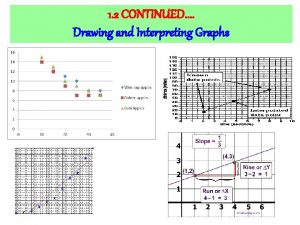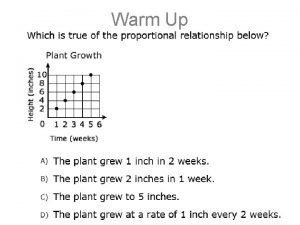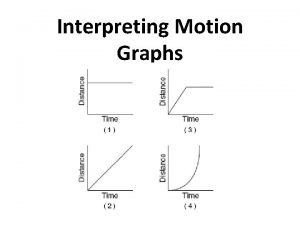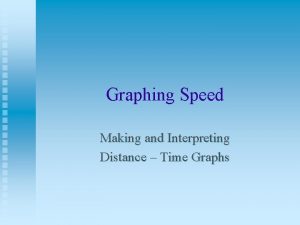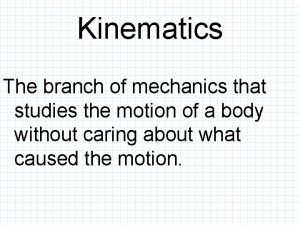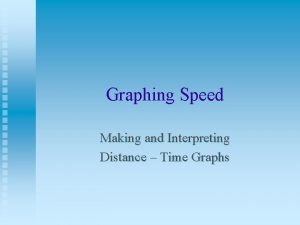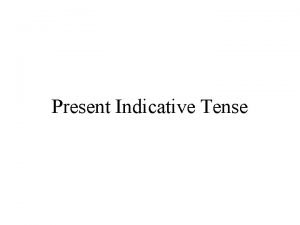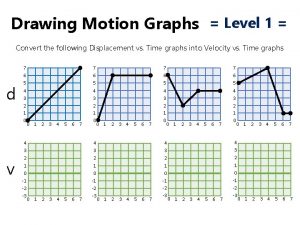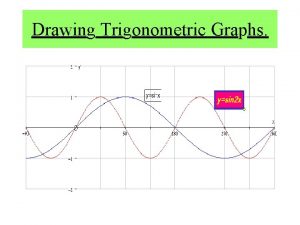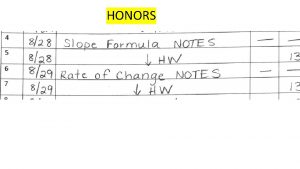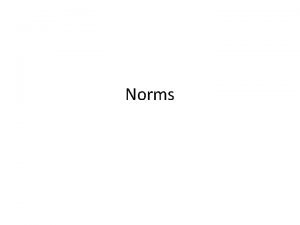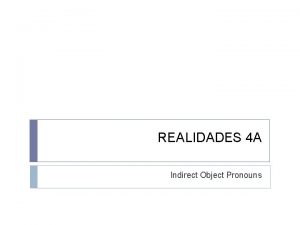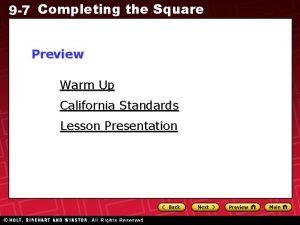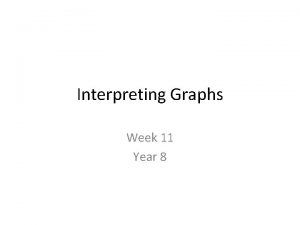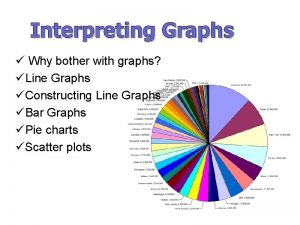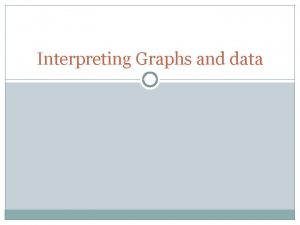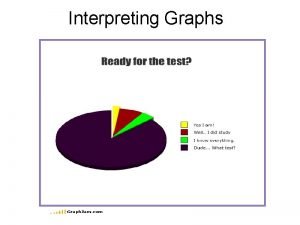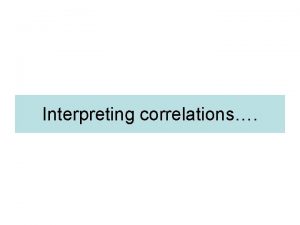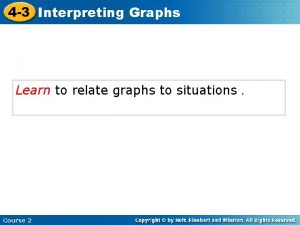1 2 CONTINUED Drawing and Interpreting Graphs Drawing
































































- Slides: 64

1. 2 CONTINUED. . Drawing and Interpreting Graphs

Drawing and Interpreting Graphs Scientific Graphs: • Most scientific graphs are made as line graphs. • The lines on scientific graphs are usually drawn either straight or curved. These lines do not have to touch all the data points, but they should at least get close to most of them. • These lines are called the best-fit lines.

Drawing and Interpreting Graphs Here are two examples of best-fit graph lines. One is drawn correctly, the other is not. Best-Fit Line #1 Best-Fit Line #2

Drawing and Interpreting Graphs WHICH GRAPH IS DRAWN CORRECTLY? ? ? Best-Fit Line #1 Best-Fit Line #2

Drawing and Interpreting Graphs Scientific Graphs: • Independent and Dependant variables

Drawing and Interpreting Graphs 10 Time (min) 9 Mass (grams) 8 Mass (grams) 0 2. 5 1 4. 7 5 2 5. 6 4 3 6. 9 3 4 7. 3 2 5 8. 9 1 6 9. 5 7 6 0 0 1 2 3 4 5 6 7 8 Time (min) This is data I obtained when I performed a certain chemical reaction. I observed and measured the change in mass of a chemical during 6 minutes.

Drawing and Interpreting Graphs 10 Time (min) 9 Mass (grams) 8 Mass (grams) 0 2. 5 1 4. 7 5 2 5. 6 4 3 6. 9 3 4 7. 3 2 5 8. 9 1 6 9. 5 7 6 0 0 1 2 3 4 5 6 7 8 Time (min) What is the dependant and what is the independent variable?

Drawing and Interpreting Graphs 10 Time (min) 9 Mass (grams) 8 Mass (grams) 0 2. 5 1 4. 7 5 2 5. 6 4 3 6. 9 3 4 7. 3 2 5 8. 9 1 6 9. 5 7 6 0 0 1 2 3 4 5 6 7 8 Time (min) independent variable: it is controlled by the experimenter (a person who does the experiment) dependent variable: it changes with the independent variable

Drawing and Interpreting Graphs 10 Time (min) 9 Mass (grams) 8 Mass (grams) 0 2. 5 1 4. 7 5 2 5. 6 4 3 6. 9 3 4 7. 3 2 5 8. 9 1 6 9. 5 7 6 0 0 1 2 3 4 5 6 7 8 Time (min) independent variable: Time (goes on x – axis) dependent variable: Mass (goes on y – axis)

Graphing Practice Problem #1 • Ethylene (C 2 H 4) is a plant hormone that causes fruit to mature. The data above concerns the amount of days (from the spraying until maturity of the fruit) versus the amount of ethylene that was used. • 1. ) Make a graph of the data • 2. ) What is the dependant variable? • 3. ) What is the independent variable?

Graphing Practice Problem #1 Number of days = dependent variable Amount of ethylene = independent variable

Drawing and Interpreting Graphs Scientific Graphs: • Extrapolation and Interpolation

Extrapolation and Interpolation • Graphs are a useful tool in science • Graphs can "predict" data which are not measured

Extrapolation and Interpolation Extrapolation: extending the graph, along the same slope, above or below measured data.

Extrapolation and Interpolation: predicting data between two measured points on the graph.

Graphing Practice Problem #2 • The volume of a gas decreases as the temperature of the gas decreases. A sample of a gas was collected at 100 degrees Celsius and then cooled down. The changes in the volume of the sample are shown below. . . 1. ) Make a graph of the data 2. ) Make a second graph which will allow you to extrapolate data to reach a gas volume of 0 ml. 3. ) The temperature at which the volume of the gas reaches zero is theoretical temperature of Absolute Zero. From this graph, what is the Celsius Temperature for Absolute Zero Volume?

The volume of a gas decreases as the temperature of the gas decreases. A sample of a gas was collected at 100 degrees Celsius and then cooled down. The changes in the volume of the sample are shown below. . . 1. ) Make a graph of the data 2. ) Make a second graph which will allow you to extrapolate data to reach a gas volume of 0 ml. 3. ) The temperature at which the volume of the gas reaches zero is theoretical temperature of Absolute Zero. From this graph, what is the Celsius Temperature for Absolute Zero Volume?

350 300 V (m. L) 250 200 150 100 50 0 -40 -20 0 20 40 60 80 T (˚C) 100 120

350 300 250 V (m. L) 200 150 100 50 0 -300 -250 -200 -150 -100 -50 0 50 T (˚C) 100 150

350 300 250 V (m. L) 200 150 100 50 0 -300 -250 -200 ≈ -270 ˚C -150 -100 -50 0 50 T (˚C) 100 150

Drawing and Interpreting Graphs Slope of The Line

Slope of the line

Slope of the line • What is the rise? • What is the Run? • What is the slope? • Is this a positive or negative slope?

Slope of the line • What is the rise? • What is the Run? • What is the slope? • Is this a positive or negative slope?

Graphing Practice Problem #4

Graphing Practice Problem #4 - Answer 1. Sketch a line with a negative slope a) negative slope b) positive slope c) zero slope

Graphing Practice Problem #4 - Answer 1. Sketch a line with a negative slope a)negative slope

Graphing Practice Problem #4 - Answer 1. Sketch a line with a negative slope b) positive slope

Graphing Practice Problem #4 - Answer 1. Sketch a line with a negative slope c) zero slope

Graphing Practice Problem #4 - Answer 2. A student weighs an empty crucible. Its mass is 20. 50 g. She adds some pieces of magnesium and then she weighs the crucible again. Its new mass is 25. 50 g. She heats the crucible and its contents and weighs it every 5 minutes. She obtains the following data: Time (min) Mass of Crucible and magnesium (grams) 5 10 15 20 25 30 35 40 25. 80 26. 20 26. 65 27. 00 27. 45 27. 85 28. 20 28. 60 Plot the mass of the crucible's contents and calculate the slope. What do you think is the significance of the slope?

Graphing Practice Problem #4 - Answer Mass of Crucible and Mg (g) 29. 5 28. 5 27. 5 26. 5 25. 5 24. 5 23. 5 0 5 10 15 20 25 Time (min) 30 35 40 45

Graphing Practice Problem #4 - Answer Mass of Crucible and Mg (g) 29. 5 28. 5 27. 5 26. 5 25. 5 24. 5 23. 5 0 5 10 15 20 25 Time (min) 30 35 40 45

Graphing Practice Problem #4 - Answer Mass of Crucible and Mg (g) 29. 5 28. 5 27. 5 Rise 26. 5 25. 5 Run 24. 5 23. 5 0 5 10 15 20 25 Time (min) 30 35 40 45

Graphing Practice Problem #4 - Answer 29. 5 Mass of Crucible and Mg (g) Slope = (27. 5 - 26. 4)/ (26 – 12) 28. 5 27. 5 Rise 26. 5 25. 5 Run 24. 5 23. 5 0 5 10 15 20 25 Time (min) 30 35 40 45

Graphing Practice Problem #4 - Answer Mass of Crucible and Mg (g) 29. 5 Slope = (27. 5 - 26. 4)/ (26 – 12) = 1. 1/ 14 28. 5 27. 5 Rise 26. 5 25. 5 Run 24. 5 23. 5 0 5 10 15 20 25 Time (min) 30 35 40 45

Graphing Practice Problem #4 - Answer Mass of Crucible and Mg (g) 29. 5 Slope = (27. 5 - 26. 4)/ (26 – 12) = 1. 1/ 14 = 0. 079 g/m 28. 5 27. 5 Rise 26. 5 25. 5 Run 24. 5 23. 5 0 5 10 15 20 25 Time (min) 30 35 40 45

Graphing Practice Problem #4 - Answer What do you think is the significance of the slope? It shows us a relationship between the change in mass of a product and time (every minute, the mass of a product increased by about 0. 08 g)

Graphing Practice Problem #4 - Answer Bonus Question: Why was the mass of a crucible and Magnesium increasing when you burned magnesium? The reaction was: 2 Mg (s) + O 2(g) 2 Mg. O(s) Mg. O is heavier than Mg!!! That is why the mass of the crucible was increasing

Drawing and Interpreting Graphs Labeling the graph

Drawing and Interpreting Graphs Scientific Graphs have to be labeled! You MUST label: a) Y and X - axis (what you are measuring + units) FOR EXAMPLE

12 Mass (grams) 10 8 6 4 2 0 0 1 2 3 4 Time (min) 5 6 7 8

Drawing and Interpreting Graphs Scientific Graphs have to be labeled! You MUST label: a) Y and X - axis(what you are measuring + units) b) Y and X - axis(put numbers on them)

12 Mass (grams) 10 8 6 4 2 0 0 1 2 3 4 Time (min) 5 6 7 8

Drawing and Interpreting Graphs Scientific Graphs have to be labeled! You MUST label: a) Y and X - axis(what you are measuring + units) b) Y and X - axis(put numbers on them) c) The graph (give name to your graph)

Change in Mass vs. Time of reaction 12 Mass (grams) 10 8 6 4 2 0 0 1 2 3 4 Time (min) 5 6 7 8

Drawing and Interpreting Graphs Scientific Graphs have to be labeled! You MUST label: a) Y and X - axis(what you are measuring + units) b) Y and X - axis(put numbers on them) c) The graph (give name to your graph) d) Any lines which you might have on the graph

Increase in Mass vs. Time of reaction 12 Mass (grams) 10 8 Student 2 6 4 Student 1 2 0 0 1 2 3 4 Time (min) 5 6 7 8

Graphing Practice Problem #5 Take a graph from Practice Problem #1 and label it correctly as we just discussed!!! • Ethylene (C 2 H 4) is a plant hormone that causes fruit to mature. The data above concerns the amount of days (from the spraying until maturity of the fruit) versus the amount of ethylene that was used. Amount of ethylene (ml/m 2) Wine sap Apples (Days to Maturity) Golden Apples (Days to Maturity) Gala Apples (Days to Maturity) 10 14 14 15 15 12 12 13 20 11 9 10 25 10 7 9 30 8 7 8 35 8 7 7

Graphing Practice Problem #5

Days to maturity (days) The number of days to the maturity of the apples vs. amount of ethylene used Amount of ethylene (ml/m 2)

Graphing – Pictorial Representation of Data as x increases, y increases as x increases, y decreases as x increases, y increases very quickly

1. Calculate slope NOT using data points 2. Write the equation of the line

1. 2 Activity: Graphing Relationship • Page 26

1. 2 Activity: Graphing Relationship 1. 2. 3. 4. Linear relationship 4˚C/min 42 ˚C Temperature = (4˚C/min) time + 22 ˚C 5. 14. 5 min (use graph or the equation) 6. Temperature of water at the beginning (room

HOMEWORK 1. 2 Review Questions Problems: 11 and 12

Interpreting Data it is also important that you be able to interpret data that are represented by a graph.

Interpreting Data Example# 1 Identify the graph that matches each of the following stories: • I had just left home when I realized I had forgotten my books so I went back to pick them up.

Interpreting Data Example # 2: Identify the graph that matches each of the following stories: • Things went fine until I had a flat tire.

Interpreting Data Example # 3: Identify the graph that matches each of the following stories: • I started out calmly, but sped up when I realized I was going to be late

Graphing Practice Problem #3 How well can you read a graph problems?

Graphing Practice Problem #3 13 33 Sleeping Going to school Talking on the phone, sleeping Phone, eating a. b. c. d. e. f. 1. The graph at the right represents the typical day of a teenager. Answer these questions: What percent of the day is spent watching TV? How many hours are spent sleeping? What activity takes up the least amount of time? What activity takes up a quarter of the day? What two activities take up 50% of the day? What two activities take up 25% of the day

Graphing Practice Problem #3 2. Answer these questions about the graph a. How many sets of data are represented? b. On approximately what calendar date does the graph begin? c. In what month does the graph reach its highest point? 2 ≈ April 10 July

Graphing Practice Problem #3 50 ≈200 – 20 = 180 0 ≈50 – 20 = 30 3. Answer these questions 260 4. a) How many total miles did the car travel? b) What was the average speed of the car 10. 4 miles/hour for the trip? c) Describe the motion of the car between The car was stopped hours 5 and 12? d) What direction is represented by line CD? Going back to the origin e) How many miles were traveled in the first About 20 two hours of the trip? DE f) Which line represents the fastest speed?

Graphing Practice Problem #3 4. Answer these questions about the graph a. How much rain fell in Mar of 1989? b. How much more rain fell in Feb of 1990 than in Feb of 1989? c. Which year had the most rainfall? d. What is the wettest month on the graph? About 5 inches 2 more inches 1989 June 1990
 Drawing and interpreting graphs
Drawing and interpreting graphs Tomer owns a daycare
Tomer owns a daycare Making science graphs and interpreting data
Making science graphs and interpreting data Interpreting circle graphs
Interpreting circle graphs Interpreting distance time graphs
Interpreting distance time graphs Interpreting proportional graphs worksheet
Interpreting proportional graphs worksheet 1-8 interpreting graphs of functions
1-8 interpreting graphs of functions Interpreting linear graphs
Interpreting linear graphs Always-on
Always-on Enzyme activity graph
Enzyme activity graph Interpreting velocity time graphs
Interpreting velocity time graphs Interpreting circle graphs
Interpreting circle graphs Interpreting line graphs year 5
Interpreting line graphs year 5 Interpreting distance time graphs
Interpreting distance time graphs Interpreting graphs
Interpreting graphs Interpreting distance time graphs
Interpreting distance time graphs Good and bad state graphs in software testing
Good and bad state graphs in software testing Graphs that enlighten and graphs that deceive
Graphs that enlighten and graphs that deceive Comparing distance/time graphs to speed/time graphs
Comparing distance/time graphs to speed/time graphs Polynomial end behavior chart
Polynomial end behavior chart Romeo and juliet act 2 continued
Romeo and juliet act 2 continued What happened in act 4 of romeo and juliet
What happened in act 4 of romeo and juliet And they continued steadfastly
And they continued steadfastly Continued proofs transversals and special angles
Continued proofs transversals and special angles Stem changing verbs spanish
Stem changing verbs spanish Romeo and juliet act v continued
Romeo and juliet act v continued Drawing motion graphs
Drawing motion graphs Drawing cumulative frequency graphs worksheet
Drawing cumulative frequency graphs worksheet How to draw a trigonometric graph
How to draw a trigonometric graph Vertex
Vertex Selecting organizing and interpreting information
Selecting organizing and interpreting information Interpreting quantitative data
Interpreting quantitative data 5-1 rate of change and slope
5-1 rate of change and slope Planning recording analyzing and interpreting
Planning recording analyzing and interpreting Research design meaning
Research design meaning Analyzing and interpreting data in research
Analyzing and interpreting data in research Analyzing and interpreting data in research
Analyzing and interpreting data in research Analyzing and interpreting literature
Analyzing and interpreting literature Analyzing and interpreting data in research
Analyzing and interpreting data in research Analyzing and interpreting data in research
Analyzing and interpreting data in research Analyzing and interpreting literature
Analyzing and interpreting literature What kind of graph is this
What kind of graph is this Analyzing and interpreting data
Analyzing and interpreting data Interpreting test scores and norms
Interpreting test scores and norms Direct object pronouns (p. 138) answers
Direct object pronouns (p. 138) answers Position cost distribution
Position cost distribution Whats signal words
Whats signal words Table continued
Table continued Continued abbreviation
Continued abbreviation Colon grammar
Colon grammar Demonstrative adjectives continued answers
Demonstrative adjectives continued answers Tu 1 of 1 montres tes photos? (us)
Tu 1 of 1 montres tes photos? (us) Compound adjectives list
Compound adjectives list 9-7 solving quadratic equations by using square roots
9-7 solving quadratic equations by using square roots Factoring trinomials: a = 1 (continued) quiz
Factoring trinomials: a = 1 (continued) quiz Completing the square (continued) quiz
Completing the square (continued) quiz Work and energy section 2 describing energy
Work and energy section 2 describing energy Section 1 atmospheric basics continued answers
Section 1 atmospheric basics continued answers How to complete the square
How to complete the square Chapter 8 section 3: cellular respiration
Chapter 8 section 3: cellular respiration Although it was raining maria went for a jog at the park
Although it was raining maria went for a jog at the park Complete the square activity
Complete the square activity Completing the square (continued)
Completing the square (continued) Address continued
Address continued Section 1 forces (continued)
Section 1 forces (continued)
